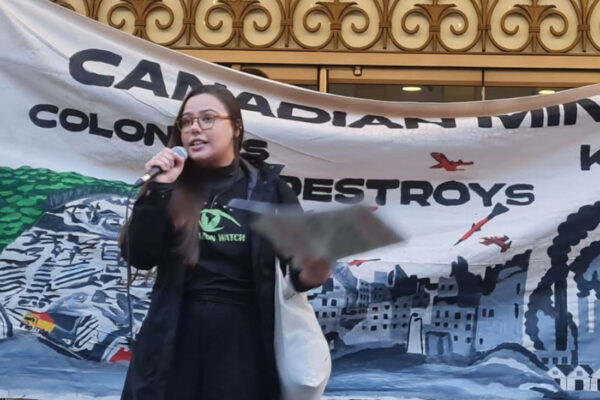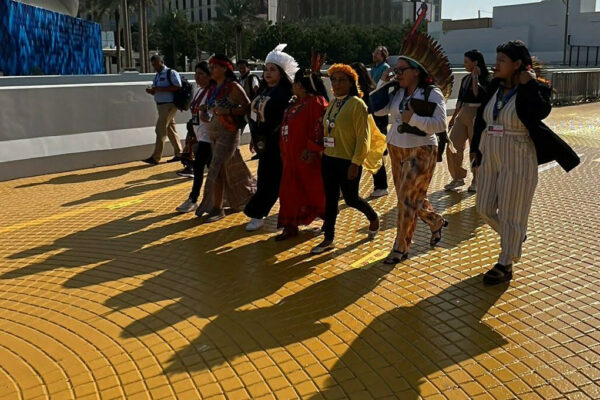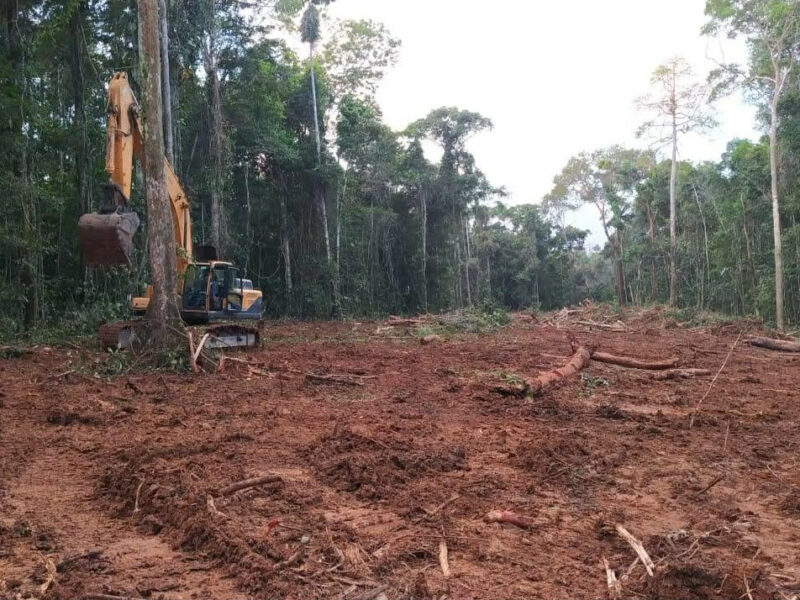
In the depths of the Ecuadorian Amazon, on its border with Peru, indigenous communities have been denouncing what they say is an uncontrolled onslaught of illegal logging and hunting. They claim that Peruvians traffickers penetrate into their territory along the Curaray River in the province of Pastaza.
The problem is about to worsen, according to ecologists. They say the destruction wrought by these illicit activities threatens not just one of the most biodiverse areas in the world, but also endangers isolated indigenous groups that live within Yasuní National Park and the adjacent Tagaeri-Taromenane Intangible Zone (ZITT). This is happening despite precautionary measures issued in 2006 by the Inter-American Commission on Human Rights (IACHR), which pressured the Ecuadorian government to safeguard the territory and the indigenous peoples that depend on it.
In response, groups like the Waoranis, Kichwas and Záparas denounced illegal logging and hunting in their territories. The latter group is located in Coca, the capital of the Amazonian province of Orellana, which was created in honor of the Capuchin missionary of the same name who dedicated his life to protecting Peoples in Isolation (PIA) from the oil and logging interests that proliferated in the territory in the late 1980s.
In 2015, indigenous resistance attracted the attention of organizations such as Land is Life, Acción Ecológica and the Alejandro Labaka Foundation. José Proaño, director of Land is Life Latin America – an international network that protects the rights of indigenous peoples – was part of the group of specialists and indigenous people that made the complaints, and traveled through the Tagaeri-Taromenane Intangible Zone (ZITT) between May 19 and 29 to corroborate claims of damage and threats to isolated groups.
During the trip, they visited three Waorani communities located within the ZITT and two Kichwa communities on the Curaray River.
“They are mainly picking cedar and chuncho [a variety of native cocoa], but to do this, they had to open trails, put cables and pulleys to remove the logs of wood that are in the forest in order to reach where the rivers flow into the ocean,” Proaño said. He said that the testimonies of the communities visited indicate that Peruvian traffickers are to blame. He added that the situation is out of control and that “loggers are going up the Curaray River in a brazen way.”
According to Proaño, this situation would have been unlikely just a few years ago due to effective patrolling by the Ecuadorian military, which maintained a significant presence in two control points of the tributary.
“Since the peace process with Peru, the border has been demilitarized, which is healthy but the effects have been disastrous,” Proaño said.
David Suárez, of the Alejandro Labaka Foundation, agrees with Proaño. He also visited the area in May.
“What we noticed is that the intrusion of logging camps in the area is much greater than what we estimated. They are in two zones,” Suárez said. The first area in which the camps are fully established is in the creek of the River Lobo, across the border. The other one, Suárez explains, is on the right bank of the Curaray River, throughout the Intangible Zone. “We have found about 18 areas, both with hunting and illegal logging. We have found complexes for drying meat, which is going to be shipped and transported to Peru, as well as remains of cedar trees logged and many others marked for future logging.”
José Proaño, director of Land is Life, explained that the traffickers are opening trails in the territory to increase logging, which for now is concentrated in the border areas. He said that the coveted timber is common because the area has been relatively undisturbed.
“The intangible area has been so protected and so well maintained by the villages that live there, that there is cedar by the river – something that does not happen in areas where there are roads or oil,” Proaño said. “The first wood that is extracted is always cedar, which is valued in the market at around US $3,000 the cubic foot.”
Suárez explained that the logging is occurring near Ecuador’s border with Peru. “You have the river Curaray River that is shared with Peru downstream. We are talking about how logging is happening quite close to the border. We are talking about an area of 8 to 15 kilometers upstream. That’s where we find the last area of logging.”
According to Proaño, the issue could worsen and spread outside the Intangible Zone.
“We are afraid that this situation of illegal logging is taking place along the entire border with Peru, in areas between the Napo River and the south along the Corrientes River,” he said.
An abandoned border
Mongabay-Latam had access to a preliminary copy of a report on illegal logging in the Tagaeri-Taromenane Intangible Zone developed jointly by Land is Life, Acción Ecológica and the Alejandro Labaka Foundation. The report reveals the complete law enforcement abandonment of the eastern part of Yasuní National Park.
It documents that, in October 2015, a group of specialists from the Ministry of Environment, the Ministry of Justice (in charge of complying with the precautionary measures issued by the IACHR) and the Armed Forces, visited an area of the Lobo River and identified logging camps.
“On the route, we heard chainsaws, but due to the scarce military presence, we did not reach the place where they were sawing,” the report stated. “On the river bank of the Nashiño River, which crosses the Intangible Zone from Ecuador to Peru, the Ministry of Environment carried out an operation and arrested three citizens of Peruvian nationality. However, the wood seized and retained in the Ecuadorian military detachment of the Nashiño River was recovered by the Peruvian loggers in a possible violent attack against the military detachment.”
The document mentions that government-monitoring activities in the area ceased between the end of 2015 and August 2016; that same month, large-scale logging and hunting camps were identified in the area. Finally, the report alleges that, based on the denunciations of indigenous people, the Ministry of Justice and the Ministry of Environment conducted surveillance in May of this year without taking effective measures to stop or prevent illicit activities.
According to David Suárez, he found two abandoned camps during his visit to the Curaray River: one for the military and another called Ceilán, implemented by the Ministry of Environment for surveillance of the southern border of Yasuní.
“Some parts of the post had been set on fire, the pump and water tank that supply the park rangers were destroyed. It had been looted and vandalized, which accounts for an absence of the Ministry of Environment in that area,” he said. “What we found is that neither the military nor civilians are receiving the resources or the supplies necessary to carry out their tasks; people in the communities argue that if the government is not able to control this, they should give them the checkpoints.”
While Suárez does not believe this would be a good solution, he still recommends government coordination with local communities.
“The government has to exercise the control that constitutionally corresponds to them, but we do believe that it should coordinate with the local population,” he said. “Bureaucratic requisitions that prevent local specialists from getting surveillance jobs should be avoided. Local specialists are going to be much more interested in preserving their territory than a person who feels punished to do this job.”
The few military personnel who remain in the area live in precarious conditions, according to Suárez: “the Cononaco detachment, which is the closest military base to the area (of permitted and illegal hunting), has a staff of no more than five people; canoes are damaged, there is no fuel, they don’t even have an endowment of food.” Under these circumstances, the military is at the mercy of the same traffickers, whom they identify under the pseudonym “fishermen.” “They entirely depend on the provisions they exchange with illegal loggers – I don’t know what the deal is. They are the ones who carry supplies to the military.”
Double pressure for isolated indigenous groups
Besides illegal logging, the Peoples in Isolation also worry about illegal hunting – particularly the hunting of collared and white-lipped peccaries, which are the main components of their diet. According to David Suárez, the area has been so well preserved that these species are plentiful.
“Their meat is very desirable for trade and illegal trafficking. Especially the white-lipped peccary,” Suárez said. “Just to set an example, people can usually hunt between one and two peccaries and feed their family, and that – even if you share it with the community – can last you two to three weeks.” Suárez added that when he visited the forest, he found camps that were able to smoke the meat of a whole herd. “The peccaries travel in groups of 100, 150, and there are reports that animals are being hunted in those numbers. It is a massive extraction; it is not a [single] poacher’s camp. They are actual complexes for drying meat.”
“We are exploiting the vital resources of isolated groups. When they hunt 100 or 150 peccaries they are taking the isolated indigenous groups’ food supply,” Suárez continued. “Another thing that could happen is the outbreak of diseases that can be fatal for these groups. For example, a t-shirt left unattended or a can of tuna can trigger an epidemic of flu, which can decimate a population that is already fragile.” He added that with all this pressure being exerted on isolated indigenous groups, “the risk of violent clashes and confrontations is imminent because the camps are getting closer to the hunting trails of the isolated villages in that area.” Suárez said that no attacks had been reported from the isolated indigenous groups within the Intangible Zone because it was a territory free of oil and timber pressures.
That apparent peace is about to change.
Risk of extinction of isolated indigenous groups
“The precautionary measures (from the IACHR) were issued due to the presence of illegal loggers in the Taromenane zone – west of Yasuní. That was the main reason,” Proaño said. He added that logging incited the massacre of 30 people from an isolated indigenous group in 2003 by members of the Waorani. “In theory, the Ministry of Justice is the one that has to protect the isolated indigenous groups, so if there are loggers, they have to take measures,” Proaño said. “These actions may be: to alert the Ministry of Environment, alert the Prosecutor’s Office, alert the Armed Forces because it is a border area and it is also violating national sovereignty.”
However, Suárez said the Ecuadorian government is not guaranteeing the intangibility of the territories of the Peoples in Voluntary Isolation or Initial Contact (PIACI in Spanish), which he says may constitute a risk of ethnocide and extinction for these groups.
“The relevant state bodies, in this case the Ministry of the Environment and the Ministry of Justice, can argue that they have done patrols and operations. We are not questioning the measures they have taken; we are [concerned about] the absolute ineffectiveness of these measures because they don’t prioritize the protection of isolated indigenous peoples. That’s the problem,” Suárez said.
Suárez acknowledged that there has been progress in generating institutionalism for the protection of the isolated indigenous groups, but these actions “have been given slowly and without being a priority in Amazonian politics.” He brought up the last massacre of isolated indigenous people in 2013 that happened to the west of the Yasuní: a group of about twenty Taromenane executed by members of the Waorani to avenge the death of an elderly couple who had allegedly been speared by the Taromenane members. Suárez said that and other similar episodes of violence are commonly associated with oil and timber pressures to which populations in isolation are exposed. For this reason, organizations such as Land is Life and the Alejandro Labaka Foundation work with the area communities to create a culture of peace and solidarity for PIAs.
“Although the government has a mandate to protect them, the neighbors of the isolated people are the ones in the area, and if their territory is threatened they will take violent actions against the loggers or other people (in isolation),” Proaño said.
Experts fear that outside pressures to which the isolated indigenous groups are subjected in the Intangible Zone will trigger new massacres and heighten the risk of extinction of these populations. In effort to stop such an outcome, the organizations Land is Life, Acción Ecológica and the Alejandro Labaka Foundation are preparing to file one complaint against illegal logging in the area at the Attorney General’s Office, and another for violation of environmental and human rights. They hope that appropriate measures will be taken through inter-ministerial coordination to cease illegal activities in the area.













